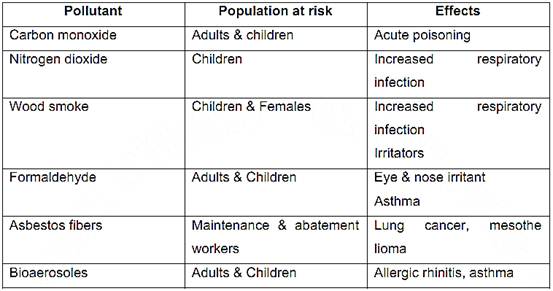


 النبات
النبات
 الحيوان
الحيوان
 الأحياء المجهرية
الأحياء المجهرية
 علم الأمراض
علم الأمراض
 التقانة الإحيائية
التقانة الإحيائية
 التقنية الحيوية المكروبية
التقنية الحيوية المكروبية
 التقنية الحياتية النانوية
التقنية الحياتية النانوية
 علم الأجنة
علم الأجنة
 الأحياء الجزيئي
الأحياء الجزيئي
 علم وظائف الأعضاء
علم وظائف الأعضاء
 الغدد
الغدد
 المضادات الحيوية
المضادات الحيوية|
Read More
Date: 28-2-2016
Date: 25-2-2016
Date: 28-2-2016
|
Air pollution
Air is most of the time, loaded with potential causes of diseases. Agents from the air like microorganisms contaminating food and water, chemical and particulate pollutants found in the air are common causes of diseases. It is important to see air pollution dividing it into an outdoor and indoor.
A-Out door air pollution
The ambient air in industrialized countries is highly contaminated with gaseous and particulate pollutants. In undeveloped countries like ours air is less polluted. Air pollution is severe in big cities like, London, Mexico city and Losangeles. In addition air may be locally spoiled in the vicinities of heavy industries.
There are six major pollutants, which collectively produce the well-known smog making some big cities difficult to live in.
To emphasize on some important points:
• Ozone is the most important pollutant in that it is produced in large amounts and has serious health consequences. It is highly reactive producing free radicals, which injures airways by virtue of release of inflammatory mediators. When healthy individuals are exposed, they experience mild respiratory symptoms, but its effects are exaggerated in people already having asthma and emphysema.
• Particulates are harmful when their diameters are less than 10μm whatever their composition may be. Larger particles are filtered out in the nares or mucocilliary system along the airways. The size of smaller particles helps them to reach into airspaces (alveoli) where they are phagocytosed by macrophages and neutrophils.
Inflammatory mediator released from these cells are the once which result in the damage.
• Even if single pollutants are able to cause lung function impairments, the results are move sever when pollutants are in a combination. It is clear that pollutants are often time available in the air combined.
• Pollutants have wide range of consequences in different organs but the lungs are the usual targets
Here is a table listing the six important pollutants, their origins and their potential consequences.
Table 1. Major outdoor air pollutants

B-Indoor air pollution
Indoor air pollution is a major problem in undeveloped countries like Ethiopia where people cook inside living rooms. Here, large number of family members dwell in single rooms where cooking activities are also undertaken .So wood smoke produced in large quantities is accumulated to affect the health of adults and children. It contains oxides of nitrogen and carbon particulates which are irritants predisposing children to repeated lung infection. Tobacco smoke is the commonest pollutant in the house of people living in developed countries but additional offenders are listed in the table below
Table 2. Health Effects of indoor air pollutants

References
Bezabeh ,M. ; Tesfaye,A.; Ergicho, B.; Erke, M.; Mengistu, S. and Bedane,A.; Desta, A.(2004). General Pathology. Jimma University, Gondar University Haramaya University, Dedub University.



|
|
|
|
تفوقت في الاختبار على الجميع.. فاكهة "خارقة" في عالم التغذية
|
|
|
|
|
|
|
أمين عام أوبك: النفط الخام والغاز الطبيعي "هبة من الله"
|
|
|
|
|
|
|
قسم شؤون المعارف ينظم دورة عن آليات عمل الفهارس الفنية للموسوعات والكتب لملاكاته
|
|
|